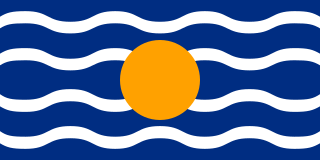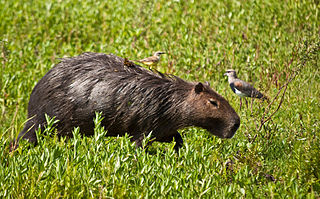Related Research Articles

Martinique is an island and an overseas department/region and single territorial collectivity of France. An integral part of the French Republic, Martinique is located in the Lesser Antilles of the West Indies in the eastern Caribbean Sea. It has a land area of 1,128 km2 (436 sq mi) and a population of 364,508 inhabitants as of January 2019. One of the Windward Islands, it is directly north of Saint Lucia, northwest of Barbados and south of Dominica. Martinique is also an Outermost Region (OMR) of the European Union and a special territory of the European Union; the currency in use is the euro. Virtually the entire population speaks both French and Martinican Creole.

Saint Kitts and Nevis, officially the Federation of Saint Christopher and Nevis, is an island country consisting of the two islands of Saint Kitts and Nevis, both located in the West Indies, in the Leeward Islands chain of the Lesser Antilles. With 261 square kilometers of territory, and roughly 50,000 inhabitants, it is the smallest sovereign state in the Western Hemisphere, in both area and population, as well as the world's smallest sovereign federation. The country is a Commonwealth realm, with Charles III as King and head of state. It is the only sovereign federation in the Caribbean.

Saint Lucia was inhabited by the Arawak and Kalinago Caribs before European contact in the early 16th century. It was colonized by the British and French in the 17th century and was the subject of several possession changes until 1814, when it was ceded to the British by France for the final time. In 1958, St. Lucia joined the short-lived semi-autonomous West Indies Federation. Saint Lucia was an associated state of the United Kingdom from 1967 to 1979 and then gained full independence on February 22, 1979.

The West Indies Federation, also known as the West Indies, the Federation of the West Indies or the West Indian Federation, was a short-lived political union that existed from 3 January 1958 to 31 May 1962. Various islands in the Caribbean that were part of the British Empire, including Trinidad and Tobago, Barbados, Jamaica, and those on the Leeward and Windward Islands, came together to form the Federation, with its capital in Port of Spain, Trinidad and Tobago. The expressed intention of the Federation was to create a political unit that would become independent from Britain as a single state—possibly similar to the Canadian Confederation, Australian Commonwealth, or Central African Federation. Before that could happen, the Federation collapsed due to internal political conflicts over how it would be governed or function viably. The formation of a West Indian Federation was encouraged by the United Kingdom, but also requested by West Indian nationalists.

German attempts at the colonization of the Americas consisted of German Venezuela, St. Thomas and Crab Island in the 16th and 17th centuries.

EMEA is a shorthand designation meaning Europe, the Middle East and Africa. The acronym is used by institutions and governments, as well as in marketing and business when referring to this region: it is a shorthand way of referencing the two continents and the Middle Eastern sub-continent all at once. It is particularly common among North American companies, and it is mostly used when dividing a company's operations by geography.
Obayi, better known as Obeah, is a Caribbean term for an ancestrally inherited body of healing and spiritual knowledge that is rooted in West African spiritual and healing traditions from places such as Ghana, Ivory Coast and Nigeria. Obeah is a syncretic body of knowledge that continues to evolve. In the Caribbean, inheritors of the tradition are referred to as "obayifo" and its priests as "bayi komfo" and "bonsam komfo", which translates to "obeah priest/priestess".
ECCM may refer to:

The genus Hydrochoerus contains two living and two extinct species of rodents from South America, the Caribbean island of Grenada, California and Panama. Capybaras are the largest living rodents in the world. The genus name is derived from the Greek ὕδωρ plus χοίρος.
Nigerian Pidgin, also called Naijá or Naija is an English-based creole language spoken as a lingua franca across Nigeria. The language is sometimes referred to as "Pijin" or Broken. It can be spoken as a pidgin, a creole, slang or a decreolised acrolect by different speakers, who may switch between these forms depending on the social setting. In the 2010's, a common orthography was developed for Pidgin which has been gaining significant popularity in giving the language a harmonized writing system.
Dame Ruth Nita Barrow, GCMG DA was the first female governor-general of Barbados. Barrow was a nurse and a public health servant from Barbados. She served as the fifth governor-general of Barbados from 6 June 1990 until her death on 19 December 1995. She was the older sister of Errol Barrow, the first prime minister of Barbados.
Charles Wade Mills was a philosopher who was a professor at Graduate Center, CUNY, and Northwestern University. Born in London, Mills grew up in Jamaica and later became a United States citizen. He was educated at the University of the West Indies and the University of Toronto.
Caribbean literature is the literature of the various territories of the Caribbean region. Literature in English from the former British West Indies may be referred to as Anglo-Caribbean or, in historical contexts, as West Indian literature. Most of these territories have become independent nations since the 1960s, though some retain colonial ties to the United Kingdom. They share, apart from the English language, a number of political, cultural, and social ties which make it useful to consider their literary output in a single category. The more wide-ranging term "Caribbean literature" generally refers to the literature of all Caribbean territories regardless of language—whether written in English, Spanish, French, Hindustani, or Dutch, or one of numerous creoles.

The coat of arms of Montserrat consists of an escutcheon (shield) charged with a woman in a green dress holding a golden harp and a black cross. In use since at least 1909, it has been the official coat of arms of the Caribbean island of Montserrat since the island became a British Crown colony in 1962. The escutcheon is featured on the flag of the territory.

The West Indies is a subregion of North America, surrounded by the North Atlantic Ocean and the Caribbean Sea that includes 13 independent island countries and 18 dependencies and other territories in three major archipelagos: the Greater Antilles, the Lesser Antilles, and the Lucayan Archipelago.
Barbadian Canadian or Bajan Canadian, refers to Canadian citizens of Barbadian descent or Barbados-born people who resides in Canada. According to the 2016 Census 37,780 Canadians claimed full or partial Barbadian ancestry. Barbadian Canadians have the highest median income and the lowest incidence of poverty among Black Canadian groups. Barbadians first start migrating to Nova Scotia in the early 1900s settling largely in the neighbourhood of Whitney Pier in Sydney. In Cape Breton, they established chapters of the United Negro Improvement Association and the African Orthodox Church. As of 2016, over 70% of the Bajan population in Canada resides in Ontario.

Horace Orlando PattersonOM is a Jamaican historical and cultural sociologist known for his work regarding issues of race and slavery in the United States and Jamaica, as well as the sociology of development. He is the John Cowles professor of Sociology at Harvard University. His book Freedom, Volume One, or Freedom in the Making of Western Culture (1991), won the U.S. National Book Award for Nonfiction.

Wakefield Street is a main thoroughfare intersecting the centre of the South Australian capital, Adelaide from east to west.

The Anglican Diocese of North East Caribbean and Aruba was originally established in 1842 as the Diocese of Antigua and the Leeward Islands when the Anglican Diocese of Barbados, then with the Diocese of Jamaica, one of the two dioceses covering the Caribbean, was sub-divided. In 1842, her jurisdiction was described as "Montserrat, Barbuda, St Kitt's, Nevis, Anguilla, Virgin Isles, Dominica". In 2017 the diocese celebrated its 175th anniversary.

Abildgaardia ovata is a perennial herb of the genus Abildgaardia and the family Cyperaceae. It is a widespread species that can be found in West, Southern and East Afria, Florida, Mexico, the Caribbean and in some countries of Latin America.
References
- ↑ Appel, H. W. (1971-01-29). "Report of mission on ports and harbours development and planning in East Caribbean countries, 1 November 1970 to 31 January 1971".
{{cite journal}}: Cite journal requires|journal=(help) - ↑ Glassner, Martin Ira (1977). "CARICOM AND THE FUTURE OF THE CARIBBEAN". Publication Series (Conference of Latin Americanist Geographers). 6: 111–117. ISSN 2160-2654.
- ↑ HUNTE, KEITH; SHOREY, LEONARD (1972). "Review of Carifta and the New Caribbean". Caribbean Quarterly. 18 (2): 55–57. ISSN 0008-6495.